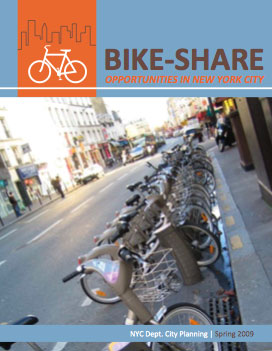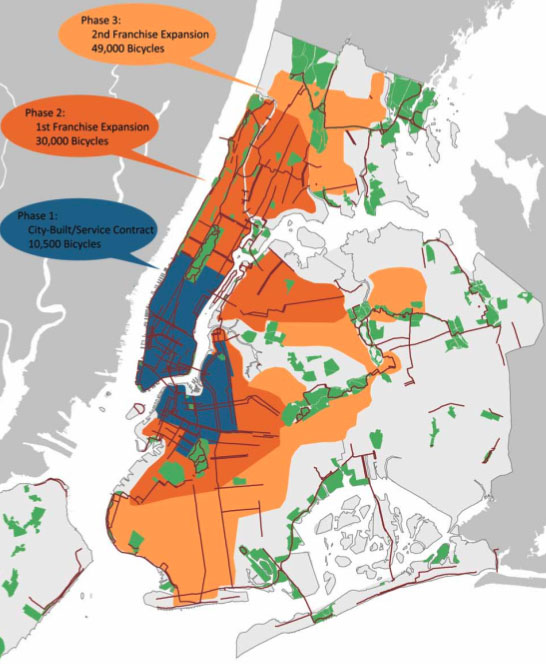Bikes as Transit: New Study Envisions Possibilities for NYC

The Department of City Planning released a study this weekend about the possibilities for bike-share in New York City, and if you can spare the time to look it over, it’s a rewarding read. The best news: The city is thinking about bike-share on a scale that would successfully integrate cycling into the public transit system. The report recommends a phased implementation, starting with a 10,000-bike system and expanding to 49,000 bikes at stations in four boroughs.
The DCP study follows DOT’s release last summer of a Request for Expressions of Interest to gauge the potential of a public bike system. City officials characterized the new report as a research document akin to a feasibility study, not an indication that bike-share implementation is imminent.
With New York’s streets crammed to capacity at peak hours and subways and buses handling historically high levels of ridership, now is an opportune moment for bike-share, which can be implemented quickly and at modest expense. A network of public bike stations as dense as Paris’s Vélib would make existing transit options more attractive and relieve crowding on packed trains and buses. Consider these examples from DCP’s report:
Over 14,000 northwest Brooklyn
residents (Greenpoint, Williamsburg, Fort Greene, etc) work in northwest Queens (Long Island
City, Astoria, Sunnyside). While the distance between these areas is short, insufficient transit
means that 42% of these commuters drive to work each day. In addition, for some households,
the introduction of a bike-share program may help them avoid or postpone the purchase of a car,
as trips to transit or other short trips could then be made by public bicycle.A subway commuter living on the
Upper East Side and working in lower Manhattan or Midtown currently walks to the Lexington
Avenue subway (4/5/6), one of the most congested subway lines in the city. With a bike-share
program in place, that commuter might bicycle to an express stop or choose to bypass the 4/5/6
all together and bicycle to 63rd or 59th Streets where transfers are available for the F and N/R/W
trains. Similarly a bike-share system would allow a Morrisania or Mott Haven resident working
at Columbia-Presbyterian, City College or Columbia University, to bicycle to the D train instead of
taking a bus or the crowded 2, 5 or 6 train into Manhattan and turning around to go back uptown
into work.
The report proposes a phased roll-out, starting where demand would be most intense and expanding to cover all of Manhattan and significant portions of the Bronx, Queens, and Brooklyn. The map comes after the jump.

As many as half a million New Yorkers would use the fully built-out network, the report estimates. I highly recommend browsing the whole document: It’s full of stats, case studies of existing bike-share systems, and scenarios for implementation here in New York. With cities like London, Montreal, and Minneapolis slated to launch bike-share systems this year or next, it makes a convincing case for New York to join their ranks.





